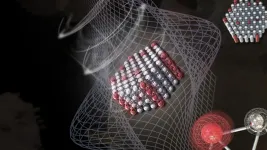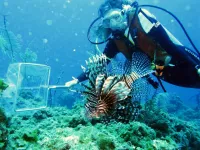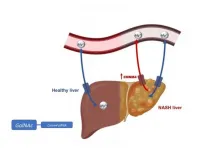(Press-News.org) Much like the Jedis in Star Wars use 'the force' to control objects from a distance, scientists can use light or 'optical force' to move very small particles.
The inventors of this ground-breaking laser technology, known as 'optical tweezers', were awarded the 2018 Nobel Prize in physics.
Optical tweezers are used in biology, medicine and materials science to assemble and manipulate nanoparticles such as gold atoms. However, the technology relies on a difference in the refractive properties of the trapped particle and the surrounding environment.
Now scientists have discovered a new technique that allows them to manipulate particles that have the same refractive properties as the background environment, overcoming a fundamental technical challenge.
The study 'Optical tweezers beyond refractive index mismatch using highly doped upconversion nanoparticles' has just been published in Nature Nanotechnology.
"This breakthrough has huge potential, particularly in fields such as medicine," says leading co-author Dr Fan Wang from the University of Technology Sydney (UTS).
"The ability to push, pull and measure the forces of microscopic objects inside cells, such as strands of DNA or intracellular enzymes, could lead to advances in understanding and treating many different diseases such as diabetes or cancer.
"Traditional mechanical micro-probes used to manipulate cells are invasive, and the positioning resolution is low. They can only measure things like the stiffness of a cell membrane, not the force of molecular motor proteins inside a cell," he says.
The research team developed a unique method to control the refractive properties and luminescence of nanoparticles by doping nanocrystals with rare-earth metal ions.
Having overcome this first fundamental challenge, the team then optimised the doping concentration of ions to achieve the trapping of nanoparticles at a much lower energy level, and at 30 times increased efficiency.
"Traditionally, you need hundreds of milliwatts of laser power to trap a 20 nanometre gold particle. With our new technology, we can trap a 20 nanometre particle using tens of milliwatts of power," says Xuchen Shan, first co-author and UTS PhD candidate in the UTS School of Electrical and Data Engineering.
"Our optical tweezers also achieved a record high degree of sensitivity or 'stiffness' for nanoparticles in a water solution. Remarkably, the heat generated by this method was negligible compared with older methods, so our optical tweezers offer a number of advantages," he says.
Fellow leading co-author Dr Peter Reece, from the University of New South Wales, says this proof-of-concept research is a significant advancement in a field that is becoming increasingly sophisticated for biological researchers.
"The prospect of developing a highly-efficient nanoscale force probe is very exciting. The hope is that the force probe can be labelled to target intracellular structures and organelles, enabling the optical manipulation of these intracellular structures," he says.
Distinguished Professor Dayong Jin, Director of the UTS Institute for Biomedical Materials and Devices (IBMD) and a leading co-author, says this work opens up new opportunities for super resolution functional imaging of intracellular biomechanics.
"IBMD research is focused on the translation of advances in photonics and material technology into biomedical applications, and this type of technology development is well aligned to this vision," says Professor Jin.
"Once we have answered the fundamental science questions and discovered new mechanisms of photonics and material science, we then move to apply them. This new advance will allow us to use lower-power and less-invasive ways to trap nanoscopic objects, such as live cells and intracellular compartments, for high precision manipulation and nanoscale biomechanics measurement."
INFORMATION:
The vegan diet is on trend. How this type of diet affects health is the subject of scientific studies. In a new study from the German Federal Institute for Risk Assessment (BfR), the bone health of 36 vegans as well as 36 people following a mixed-food diet was determined with an ultrasound measurement of the heel bone. The result: on average, people following a vegan diet had lower ultrasound values compared to the other group. This indicates poorer bone health.
In the study, the scientists also determined biomarkers in blood and urine. This aims ...
Managing invasive species--not eliminating them altogether--is a better use of time and conservation resources in many cases, according to a study led by a University of Alberta biologist.
Every year, hundreds of introduced species cause billions of dollars in damage to ecosystems, agriculture and infrastructure in North America alone. The research, led by Stephanie Green, makes a case for working smarter, not harder, to temper the impact of destructive and widespread invasive species using a strategy called functional eradication.
"Rather than trying to completely eliminate invasive species that have spread over large areas, which is very ...
Typically, light emitted from standard lasers has a controllable degree of freedom (DoF) which may be polarisation or beam shape. By suitably manipulating a laser with the introduction of specialised optical components, an output with 2 DoFs, such as vector vortex beams with controllable polarisation and orbital angular momentum (OAM). The term 'vector' describes a structured change in the polarisation across the beam and 'vortex' describes the twisting of the phase in the beam (OAM), much like a twisting tornado. Transcending 2 DoFs from a laser was not possible. By exploiting ray-wave duality in a frequency-degenerate laser, ...
Being older, overweight and having low haemoglobin levels (fewer red blood cells) could increase a patient's risk of developing debilitating nerve damage following chemotherapy, a research team led by UNSW Sydney has revealed.
The researchers aimed to identify pre-treatment clinical and blood-based risk factors in patients who developed chemotherapy-induced peripheral neuropathy (CIPN) - nerve damage in peripheral body parts, like hands or feet, as a result of chemotherapy.
The study, published in JAMA Network Open recently, examined patients - mostly women - who received paclitaxel or oxaliplatin chemotherapy treatment, which are common treatments for breast, colorectal and gynaecological ...
In a colourful solution to a dangerous problem, Australian scientists are adapting a component from cutting-edge solar cells to design a rapid, light-based detection system for deadly toxins.
While use of chemical warfare agents like sulfur mustard - better known as mustard gas - is banned internationally, we do rely on other strictly-controlled chemicals for agriculture, industry and throughout our daily lives, including fumigants like methyl iodide, which is used to control insects and fungi. The wrong amounts or incorrect use of these fumigants can be harmful to people and degrade the ozone layer.
Because it's invisible and doesn't smell, it's hard to tell whether there are dangerous amounts of methyl iodide present, and until ...
An international team of researchers has identified the CNNM4 protein as a key regulator of magnesium in the liver and potential therapeutic target for non-alcoholic fatty liver disease, according to a study published in the Journal of Hepatology.
Non-alcoholic steatohepatitis, a form of fatty liver disease characterized by inflammation and liver fibrosis, is associated with obesity and has a worldwide prevalence of 1.7 billion people.
Unhealthy nutritional habits and dietary imbalances are recognized as causes of many diseases. Magnesium is widely available in both plant and animal foods; most vegetables, legumes, peas, beans, and nuts are rich in magnesium, as are some ...
An exquisitely detailed global ocean model simulation from the National Center for Atmospheric Research (NCAR) has given scientists rare insight into where baby sea turtles may go in their "lost years" after they scramble off the sandy beaches where they are born and swim into the open ocean.
This look at a critically important period in the life cycle of endangered loggerhead turtles could help inform more comprehensive conservation efforts that encompass regions of the open ocean where young turtles grow, and not just the nesting beaches. It also pinpoints regions of the ocean that are important to study to better understand how to protect sea turtles. ...
DALLAS, March 4, 2021 -- The rate of cardiovascular risk factors among Hispanic/Latino people living in the U.S. is very high, and while they are often aware of their health conditions, less than half of the Hispanic/Latino adults with history of stroke or transient ischemic attack (TIA) had healthy blood pressure and cholesterol, and about half had healthy blood sugar levels, according to new research published today in Stroke, a journal of the American Stroke Association, a division of the American Heart Association.
According to the American Heart Association, from 2015 to 2018, 52.3% of Hispanic men and 42.7% of Hispanic women aged 20 years and older had cardiovascular disease (CVD).
"It's a wake-up call for ...
Bottom Line: Cancer survivors had a greater risk of reduced ambulatory function, which was associated with an increased risk of death.
Journal in Which the Study was Published: Cancer Epidemiology, Biomarkers & Prevention, a journal of the American Association for Cancer Research
Author: Elizabeth Salerno, PhD, MPH, assistant professor of surgery at Washington University School of Medicine in St. Louis, who conducted the research at the National Cancer Institute
Background: The diagnosis and treatment of cancer has been shown to be associated with poor functional health for common cancer types, such as those of the breast and prostate, but less is known about the association for other cancers, explained Salerno. "Given that cancer survivors are living longer than ever, ...
A new study led by Washington University School of Medicine in St. Louis and the National Cancer Institute (NCI) has identified an association between slow walking pace and an increased risk of death among cancer survivors.
While the study does not establish that slow walking is a cause of death, the association persisted across at least nine tumor types. Investigators now call for more research into these relationships and whether targeted interventions such as physical activity programs could help cancer survivors improve their ability to walk and increase survival after cancer diagnosis and treatment.
The study, a collaboration between Washington University, the NCI of the ...





